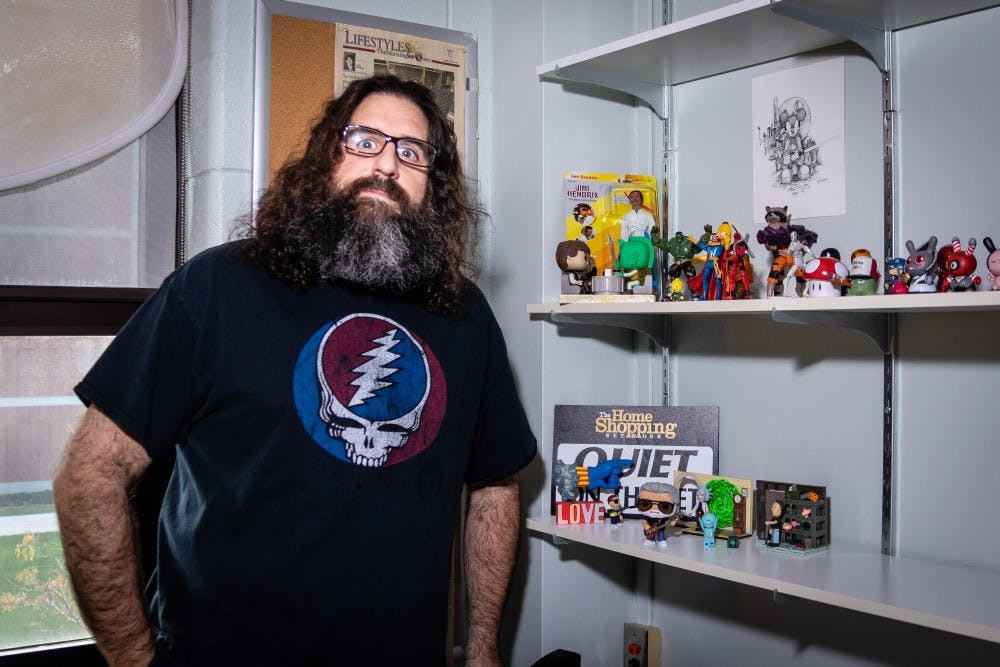Film professors dissect elements of horror movies
There is a lot that goes into making a good horror movie.
Central Michigan University School of Broadcast and Cinematic Arts faculty members Eric Limarenko, Jeffrey Smith and Patricia Williamson shared their insight on the components that make horror films successful.
They said lighting, sound and cinematography are the most important technical elements to horror films.
“Lighting allows you to have the contrast of the dark corners and things that are hidden,” Williamson said. “The sound is really important because it really heightens the experience and allows you to have anticipation in the audience.”
Limarenko stressed the importance of background sounds and music.
“Try watching a horror film without music, with just dialogue, it would almost seem like a comedy,” Limarenko said. “You need those droning sounds and the scary music.”
Smith said lighting and cinematography raise the tension of a film by how it is lit and how the camera follows the main subject.
In addition to technical aspects, the storyline, editing and scare tactics are important to the quality of horror films.
“You need a good storyline, something other than just jump scares and gore,” Williamson said. “It’s finding this combination of a premise that’s scary or an aesthetic that’s kind of creepy, and solid writing, solid production values and good acting.”
The suspense in films allows the fear of the audience to be built up.
“If a film is edited correctly, it follows Hitchcock’s rules in building suspense like you build crescendos in music,” Limarenko said. “Letting the moment happen, getting the reaction out of your audience, letting them breathe and building faster and faster frame rates.”
Limarenko said making a storyline scary requires a sense of realism.
“With horror specifically, it really works if your audience can relate to it in a way that there is just a tinge of reality, or plays on their fears,” Limarenko said. “If I have a thread of reality that plays on their common fears, then it works really well.”
Williamson said a large part of being able to create good horror films is being innovative.
Smith said his favorite horror films are the ones that bring some artistry to scaring people.
“We as a generation now are so versed in horror that we sort of know most of the normal elements of horror films,” Smith said. “If you get a director or writer who really knows what they’re doing, they’ll play with that and will give you the opposite of what you’re expecting.”
Each professor believed low-budget horror films are known for being better than the high-budget ones.
“You don’t need a large budget for a horror film, but you need to work smart,” Williamson said. “You need to be able to focus on what the audience can’t see.”
Smith said one should never dismiss low-budget horror films, because it is likely they will be the best ones.
Although Limarenko, Smith and Williamson all agree on the most important aspects of horror films, there is a wide variety in their favorites.
Limarenko said his favorite horror and suspense films are “E.T.,” “A Nightmare on Elm Street,” “Friday the 13th,” “The Exorcist” and “The Birds.”
Williamson said the most notable horror films to her are “Halloween,” “The Shining,” “Rosemary’s Baby,” “Psycho,” “The Birds,” “Raw,” “It Follows,” “Get Out,” “A Quiet Place” and “Let the Right One In.”
Smith said his favorite from the genre are “Slap Stick,” “Ghost Story,” “A Nightmare on Elm Street,” “1408,” “Dracula,” “The Purge,” “Frankenstein,” “The Slasher,” “Psycho” and “Killer Clowns from Outer Space.”
“There is such a broad range of scary movies and what people find scary, it is just finding the thing that triggers something in you, that you find it very compelling,” Williamson said.







